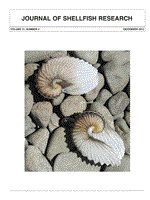The diet of the keyhole limpet Megathura crenulata was determined from stomach contents of 119 specimens collected from 3 rocky reefs on the west coast of the Baja California Peninsula, Mexico, in July and November 2006 and March 2007. Limpet stomachs contained 78 taxa, including filamentous cyanobacteria, diatoms, brown and red algae, marine seagrass, foraminifera, hydrozoans, bryozoans, nematodes, bivalves, gastropods, crustaceans, and tunicates. The main food items (>10% index of relative importance) consumed by the limpet were a tunicate; red algae of the genera Callophyllis, Coralina, Cryptopleura, Nienburgia, Pterosiphonia, and Rhodymenia; the brown algae Cystoseira osmundacea; the hydrozoan Eudendrium; and the bryozoan Crisia. Despite the differences in composition and abundance of the main items among sites and dates, the food groups of tunicates and algae account for more than 80% index of relative importance of the diet. The trophic niche breadth (Levin's index) was 0.52 ± 0.20. Our findings show that M. crenulata is an omnivorous gastropod that feeds primarily on tunicates and red algae, although it consumes other algae and invertebrates associated with their main food source.
How to translate text using browser tools
1 August 2013
Diet of the Keyhole Limpet Megathura crenulata (Mollusca: Gastropoda) in Subtropical Rocky Reefs
Alejandra Mazariegos-Villarreal,
Alejandra Piñón-Gimate,
Fátima Aguilar-Mora,
Marco Medina,
Elisa Serviere-Zaragoza
ACCESS THE FULL ARTICLE

Journal of Shellfish Research
Vol. 32 • No. 2
August 2013
Vol. 32 • No. 2
August 2013
algae
ascidians
gastropods
Megathura crenulata
omnivore
stomach contents
tunicates




